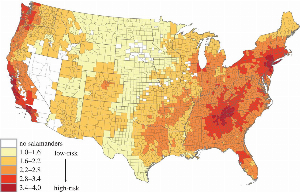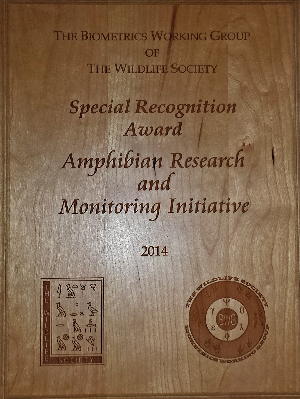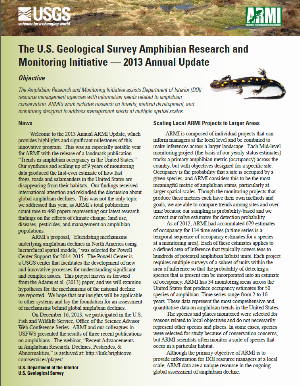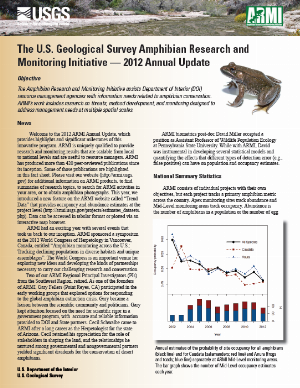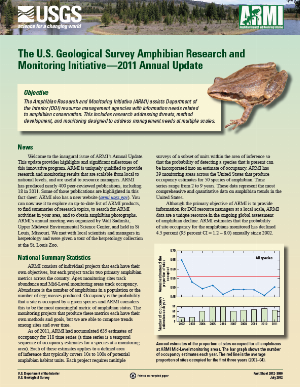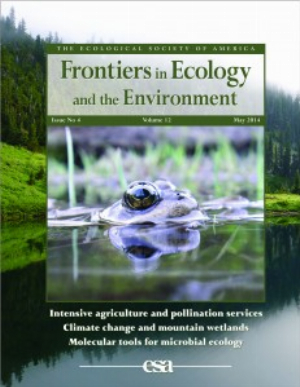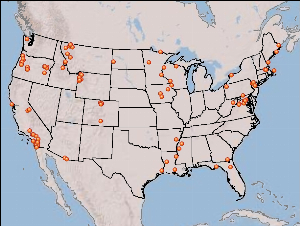Search ARMI Database
Search term(s)
Contribution Number
Search Results
117 record(s) found.
Papers & Reports Even with forewarning, challenges remain in developing a proactive response to emerging infectious diseases
Papers & Reports Quantitative evidence for the effects of multiple drivers on continental-scale amphibian declines
Papers & Reports Spatial variation in risk and consequence of Batrachochytrium salamanderivorans introduction in the United States
Papers & Reports Salamander chytrid fungus (Batrachochytrium salamandrivorans) in the United States — Developing research, monitoring, and management strategies
Papers & Reports Herpetological monitoring and assessment on the Trinity River in Trinity County, California: Final Report
Papers & Reports ARMI 2014 Annual Update
Papers & Reports Using occupancy models to accommodate uncertainty in the interpretation of aerial photograph data: status of beaver in central Oregon, USA
News & Stories ARMI recognized!
The 2014 Special Recognition Award from The Wildlife Society's Biometrics Working Group was presented to the Amphibian Research and Monitoring Initiative. The award is meant to recognize a group or an individual that has made an outstanding contribution to the development and application of quantitative methods to the fields of wildlife science and management. This year the award is presented to the Amphibian Research and Monitoring Initiative (ARMI) implemented by the U.S. Geological Survey and the U.S. Fish and Wildlife Service. ARMI has shown a deep appreciation for biometrical methods and their importance for drawing inferences about biological populations and communities. Most significantly ARMI propelled forward the development of a class of models (occupancy) that is now used worldwide by ecologists and conservation biologists. This funding support was largely responsible for dozens of papers on the development of occupancy modeling and for the 2006 book (MacKenzie et al. 2006, Academic Press; see Acknowledgements in this book) summarizing developments to that time. This development has not only been useful to ARMI projects, but has also benefited the worldwide community of animal ecologists, wildlife managers, and the field of biometrics.
News & Stories ARMI recognized!
The 2014 Special Recognition Award from The Wildlife Society's Biometrics Working Group was presented to the Amphibian Research and Monitoring Initiative. The award is meant to recognize a group or an individual that has made an outstanding contribution to the development and application of quantitative methods to the fields of wildlife science and management. This year the award is presented to the Amphibian Research and Monitoring Initiative (ARMI) implemented by the U.S. Geological Survey and the U.S. Fish and Wildlife Service. ARMI has shown a deep appreciation for biometrical methods and their importance for drawing inferences about biological populations and communities. Most significantly ARMI propelled forward the development of a class of models (occupancy) that is now used worldwide by ecologists and conservation biologists. This funding support was largely responsible for dozens of papers on the development of occupancy modeling and for the 2006 book (MacKenzie et al. 2006, Academic Press; see Acknowledgements in this book) summarizing developments to that time. This development has not only been useful to ARMI projects, but has also benefited the worldwide community of animal ecologists, wildlife managers, and the field of biometrics.
Papers & Reports Short-term occupancy and abundance dynamics of the Oregon Spotted Frog (Rana pretiosa) across its core range
Papers & Reports ARMI 2013 Annual Update
Full text: https://armi.usgs.gov/docs/ARMI%202013%20Annual%20Update.pdf
Papers & Reports ARMI 2012 Annual Update
Full text: http://armi.usgs.gov/docs/ARMI%202012%20Annual%20Update.pdf
Papers & Reports ARMI 2011 Annual Update
Full text: http://armi.usgs.gov/docs/ARMI%202011%20Annual%20Update.pdf (PDF*)
Papers & Reports Amphibians in the climate vice: loss and restoration of relilience of montane wetland ecosystems of the American West
Papers & Reports Trends in amphibian occupancy in the United States
Papers & Reports Roles of habitat, restoration, and drought frequency in driving long-term trends of a widespread amphibian
Keywords:

